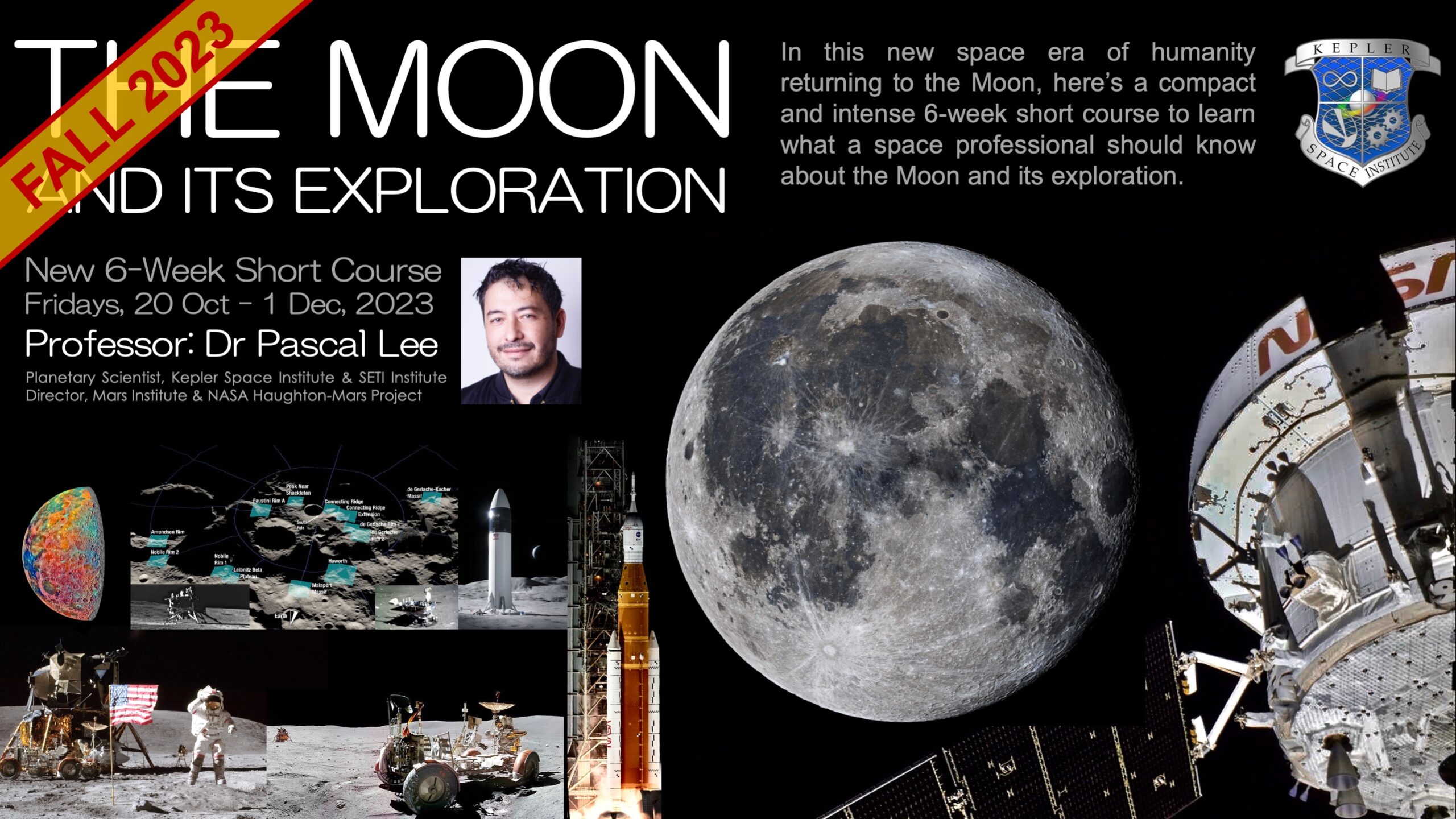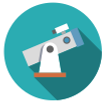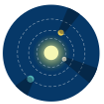The Moon and Its Exploration
In the current new space era of humanity returning to the Moon, THE MOON AND ITS EXPLORATION is a compact, intense, 6-week short course on what a space professional should know about the Moon. The course covers in particular fundamentals about the Moon as a celestial body, the history of its exploration up to the present, scientific knowledge gained about its origin and geologic evolution, challenges to lunar exploration especially at the poles, a global survey of current efforts to explore this new world, future uses of the Moon, and much more.
Recommended prerequisites for students : This short course is taught in English. It requires only basic general education but a strong desire and commitment to learn about the subject. Recommended reading will be suggested at three different levels: 1. introductory; 2. topical; 3. advanced.
12 hours
Learning Objectives
After taking this short course, the participant will have a professional working knowledge and understanding of the Moon and of its exploration history, present programs, and future opportunities. Professionals in space and related fields, students interested in aerospace engineering, robotics, space missions, astronomy, astrophysics, earth and planetary sciences, will acquire through this course a solid foundation in state-of-the-art lunar science and exploration.
Course Outline
This 6-week short course will be offered over a period of 7 weeks, from Oct 20 to Dec 1, 2023 meeting online once a week on Fridays for two consecutive hours from 7 pm to 9 pm ET (no class on Fri, Nov 24). Assignments will consist of recommended weekly reading at three different optional levels: i. introductory; ii. topical; iii. advanced. Instructor will also offer to meet online with each participant one on one for academic and professional advising.
The Moon As Natural Satellite of the Earth (Week 1)
Mass, size and shape of the Moon. Orbital characteristics of the Moon. Motion of the Moon. Lunar terrain and topography. Solar Illumination, temperature, and eclipses on the Moon. Permanently Shadowed Regions (PSRs). Earth visibility from the Moon
2 hours
History of Lunar Exploration (Week 2)
Early Earth-based observations of the Moon. Lunar mission trajectories and profiles. Early robotic missions to the Moon. Apollo Program and Apollo Astronaut Training for the Moon. Apollo 8, 10, and 13 missions. Apollo 11, 12 and 14 missions. Apollo 15, 16 and 17 missions. Mission Control, Capcom, and the science backroom during Apollo.
2 hours
Geology and Origin of the Moon (Week 3)
Geophysics and internal structure of the Moon. The surface of the Moon. Lunar highlands. Lunar mare. The Lunar Regolith. Lunar Samples and Meteorites. Dust on the Moon. Lunar Surface Processes. Impact Cratering on the Moon. Lunar Volcanism. Lunar Tectonism. Solar Wind Interactions on the Moon. Ionizing Radiation on the Moon. Electrostatics on the Moon. Micro-meteoritic gardening on the Moon. Origin of the Moon.
2 hours
Special Areas and Features on the Moon (Week 4)
South Pole Aitken Basin. Schrödinger Basin. Lunar Polar Regions. Water on the Moon. Pits and Caves on the Moon. Reiner Gamma and Other Lunar Swirls. Aristarchus, Copernicus, Tycho, Clavius and Philolaus Craters. The Lunar Far Side.
2 hours
Return to the Moon (Week 5)
Post-Apollo robotic missions to the Moon. Constellation. Artemis program. Lunar Gateway. SLS, Orion, and the SpaceX and Blue Origin. Human Landing Systems (HLS). Artemis 1 and 2 missions. Artemis 3 mission. Artemis Base Camp. Lunar spacesuits. Lunar rovers (crewed). Lunar exploration instruments and tools. Mission Support, Capcom, and science support for Artemis. NASA’s Commercial Lunar Payload Services (CLPS) program. Europe, China, Russia, India, Japan, Israel, Canada, and Australia’s lunar missions & programs. China, Russia and other crewed lunar mission plans and programs.
2 hours
Future of the Moon (Week 6)
Future lunar and planetary science and exploration on the Moon. Radioastronomy from the Moon. Lunar resources and in-situ resource utilization (ISRU). Law and war on the Moon. Private access and enterprise on the Moon. Lunar commerce. How to start your Moon business? Where to set up a base on the Moon? Lunar tourism. Lunar settlement. Moon to Mars. The Moon in Science-Fiction: The Good, the Bad, and the Impossible.
. 2 hours
Instructor Biography
Dr Pascal Lee is a planetary scientist with the Mars Institute, the SETI Institute, and NASA Ames Research Center in Mountain View, California. He is also a professor of planetary sciences at Kepler Space Institute.
Pascal Lee studied physics and geology at the University of Paris, and obtained his PhD in astronomy and space sciences at Cornell University where he was Carl Sagan’s last T.A. (Teaching Assistant).
Dr. Lee’s research focuses on the Moon and Mars. He is internationally known for his work on the history of water on Mars – in particular for proposing the “Mars Always Cold” model of Mars climate evolution -, the study of ice and caves on the Moon, the origin of Mars’ moons, and planning the future human exploration of the Moon and Mars. Dr Lee has worked on several advancements in strategies and technologies for future Moon and Mars exploration, including habitats, rovers, aircraft, hoppers, drills, and spacesuits. Dr. Lee has led over 30 expeditions to the Arctic and Antarctica to study the Moon and Mars by comparison with the Earth. In 1988, he wintered over for 402 days in Antarctica at Dumont d’Urville Station in Adélie Land. Dr Lee is also founder and director of the NASA Haughton-Mars Project (HMP), the world’s leading planetary analog field research project on Devon Island in the High Arctic. As part of the HMP, he led the historic Northwest Passage Drive Expedition, a record-setting multi-vehicular expedition on sea-ice and the subject of the award-winning documentary motion picture film Passage To Mars (2016).
Dr Lee also does research on SETI, or Search for Extraterrestrial Intelligence, and on interstellar travel. He was first to suggest, based on his reanalysis of the Drake Equation, that the number N of advanced civilizations in the Milky Way galaxy is likely very small, possibly N~1. The result would resolve the Fermi Paradox and place greater chances of finding extraterrestrial civilizations outside our galaxy than within. Dr Lee has also been advocating the use of torpor, a form of hibernation practiced in the Arctic, as a possible means of distant interplanetary and interstellar survival and travel.
Dr Lee is a recipient of the United States Antarctic Service Medal, of several NASA group achievement awards, of the National Space Society Space Pioneer Award for science and engineering, and of the Sagan Prize for the popularization of science. Dr Lee’s first book, Mission: Mars, won the 2015 Prize for Excellence in children’s science books from the American Association for the Advancement of Science.
In his free time, Pascal likes to fly and paint, although not at the same time. He is an FAA-certified helicopter commercial pilot and flight instructor, and an artist member of the International Association of Astronomical Artists. His artwork on Mars exploration and spacetime travel can be found in collections worldwide.
Dr. Pascal Lee
Instructor Dr Pascal Lee is a planetary scientist with the Mars Institute, the SETI Institute, and NASA Ames Research Center in Mountain View, California. He is also a professor of planetary sciences at Kepler Space Institute. Pascal Lee studied physics and geology at the University of Paris, and obtained his PhD in astronomy and space sciences at Cornell University.
FAQs
Who can enroll?
When do courses start?
Will the sessions be recorded?
How do I take a course?
What are the requirements to become a student?
The platform is available on desktops and mobile devices. Please have your mic and camera ready to participate. Develop new skills and gain new experiences as you learn alongside others building humanity’s future in space.




